
Lath and plaster walls can be difficult to hang things on since they are often thicker and more durable than drywall.
Unlike drywall, lath and plaster walls are constructed of thin wooden slats, or laths, and covered in a coating of gypsum plaster.
It is crucial to use the correct methods and hardware to hang items firmly without harming the walls because of the special construction of these walls.
This article will offer a thorough overview of how to hang things on lath and plaster walls, covering everything from selecting the finest hardware to avoiding damage.
This advice will assist you in producing a safe and polished result, whether you are hanging a picture, a mirror, or a piece of art.
To hang objects on lath and plaster walls, use proper hardware, locate studs, consider alternative methods, and maintain hanging objects.
Understanding the structure of lath and plaster walls

Walls made of lath and plaster have been a common style of construction for ages, especially in older structures.
To make them, craftsmen use a wooden framework that they plaster with gypsum.
Laths, which are thin wooden slats fastened to the wall studs, make up the wooden framework.
The plaster is applied over the laths in a thin, even layer, acting as a support structure.
Plaster forms a firm, long-lasting wall surface that is excellent for painting or wallpapering once it has dried.
If you need to mount heavy or large objects on your walls, you may prefer to use lath and plaster walls instead of drywall because they are thicker and more durable.
However, because the walls are stronger and thicker, it might also be more challenging to find studs for hanging things.
When hanging items, it’s important to use studs as they provide a strong support system that you can fasten into the wall securely.
Choosing the right hardware for hanging objects

Choosing the proper hardware is crucial when hanging items on lath and plaster walls.
The weight of the object you’re hanging and the type of wall you have will determine the sort of hardware you select.
Simple picture hooks or adhesive strips can be utilized for lighter items, like miniature photographs or artwork.
Use stronger hardware made specifically for lath and plaster walls when hanging larger items like mirrors or huge paintings.
| Hardware | Ideal For | Advantages |
| Toggle Bolt | Heavy Objects | Strong hold, can be used with or without studs. |
| Molly Bolt | Heavy Objects | Strong hold, can be used with or without studs. |
| Picture Hanger | Light to Medium Object | Easy to install, can be used with or without studs. |
| Command Strips | Light Objects | No damage to walls, easy to remove. |
| Magnetic Hangers | Light Objects | No damage to walls, easy to install and remove. |
| Cup Hooks | Light Objects | Can be used with or without studs, easy to install. |
| Adhesive Hooks | Light Objects | No damage to walls, easy to install and remove. |
Note: To ensure that you are using appropriate hardware for hanging an object, it is always best to double check the weight limit and manufacturer’s instructions beforehand.
There are some highly rated hardware products for hanging objects on lath and plaster walls that you can find on Amazon
Command Picture Hanging Strips
These adhesive strips are an easy and affordable option for hanging lightweight objects on lath and plaster walls.
Hillman Group Screw
These screw-in hooks are made of durable steel and can be used to hang heavier objects on lath and plaster walls.
TOGGLER SnapSkru Self-Drilling Drywall Anchors
Wall anchors are designed to support heavy loads on lath and plaster walls and are easy to install.
The Hillman Group Toggle Bolts
Toggle bolts are ideal for hanging heavy objects on lath and plaster walls. Manufacturers produce them using high-quality steel and make them available in different sizes to accommodate various weight limits.
HILTI Hollow Wall Anchors
A trusted brand designs these wall anchors to provide a secure and stable hold for heavy objects on lath and plaster walls.
Note: These product recommendations are based on their popularity and customer reviews on Amazon.
How to locate studs in lath and plaster walls
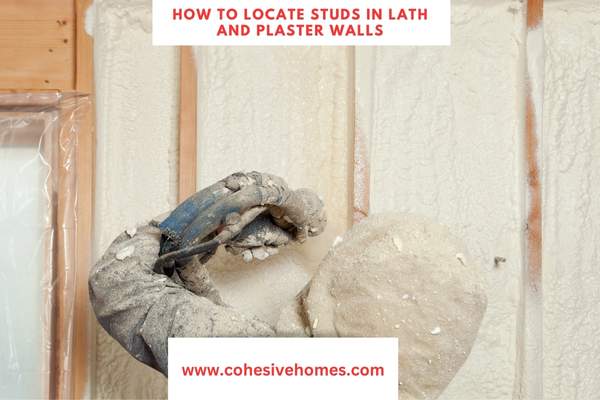
Locating studs in lath and plaster walls is an important step in hanging objects securely and without damaging the walls.
Studs provide a solid support structure for the object you’re hanging and are crucial for ensuring the object stays in place.
Here are some steps to help you locate studs in lath and plaster walls.
Use a stud finder: A stud finder is a hand-held device that can detect the location of studs behind the wall. Simply move the stud finder along the wall until it indicates the location of a stud.
Tap the wall: Tap the wall with your knuckles or a small hammer and listen for a solid sound. This is an indicator that you have found a stud.
Measure the wall: Measure 16 inches from the corner of the room and mark the spot. This is likely where a stud will be located andRepeat this step every 16 inches until you have located all the studs in the wall.
Check electrical outlets and switches: Studs are often located near electrical outlets and switches. Use this as a reference point to find the studs in the wall.
Use a magnet: To find screws or nails in the wall, which are usually located in the center of a stud, you can use a magnet. Hold the magnet against the wall and move it slowly along the surface until it sticks to a screw or nail.
Follow these steps to hang objects securely without damaging the walls.
Techniques for hanging heavy objects

When hanging heavy objects on lath and plaster walls, it’s important to use the right technique to ensure that the object stays in place and does not damage the wall.
Here are some techniques to keep in mind when hanging heavy objects.
- Use heavy-duty hardware: When hanging heavy objects, it’s important to use heavy-duty hardware that is specifically designed for lath and plaster walls. This includes toggle bolts, wall anchors, and screw-in hooks.
- Install hardware properly: Make sure to follow the manufacturer’s instructions and guidelines when installing the hardware. This will ensure that the hardware is installed securely and will provide a stable hold for the object you’re hanging.
- Use multiple points of support: For particularly heavy objects, it’s recommended to use multiple points of support. This can be achieved by using multiple hardware pieces or by installing a wooden cleat behind the wall for additional support.
- Test the object: Once you have hung the object, test it to ensure that it is secure and stable. Give the object a gentle push to make sure it does not move or wobble. If it does, you may need to adjust the hardware or add additional support.
To make sure that your heavy goods are securely and safely hung on lath and plaster walls, you can use these methods.
To prevent injuries and wall damage when handling large goods, always exercise caution and adhere to the manufacturer’s instructions.
Hanging objects without damaging the walls
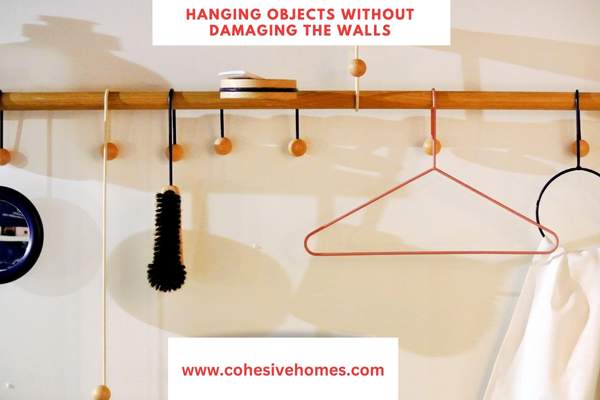
It’s crucial to take precautions to protect the walls while hanging things on lath and plaster walls.
Below are a few tips for safely hanging goods without damaging walls.
Adhesive Strips
Adhesive strips are a great option for hanging lightweight objects on lath and plaster walls.
They do not require any holes to be drilled into the wall and are easy to remove, making them a great option for renters or those who want to avoid damaging the walls.

Proper Hardware

When hanging heavier objects, make sure to use the proper hardware for lath and plaster walls.
This includes heavy-duty wall anchors, toggle bolts, and screw-in hooks.
Drill with a low RPM setting
Use a drill with a low RPM speed for drilling into lath and plaster walls to prevent the plaster from breaking or chipping.

Wall Anchors
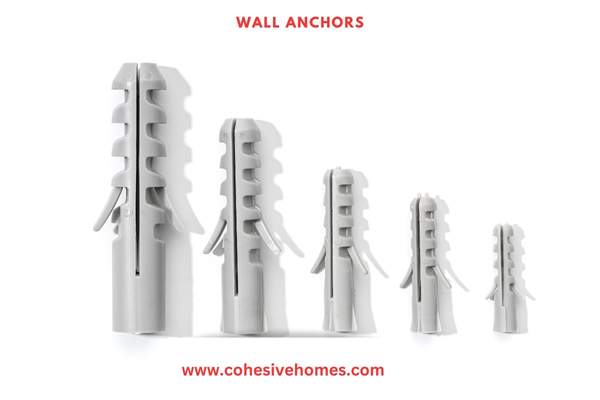
Wall anchors are a great option for hanging objects on lath and plaster walls without damaging the walls.
They provide a stable hold and distribute the weight of the object evenly across the wall, reducing the risk of damage.
Avoid over-tightening the Hardware
Overtightening the hardware can cause damage to the lath and plaster walls.
Make sure to tighten the hardware just enough to ensure that the object is secure but not so much that it damages the walls.
You can hang things on lath and plaster walls without causing any damage by following these suggestions.
When working with hardware and drilling into walls, exercise extreme caution and follow the manufacturer’s guidelines to prevent personal harm and wall damage.

Alternative methods for hanging objects on lath and plaster walls
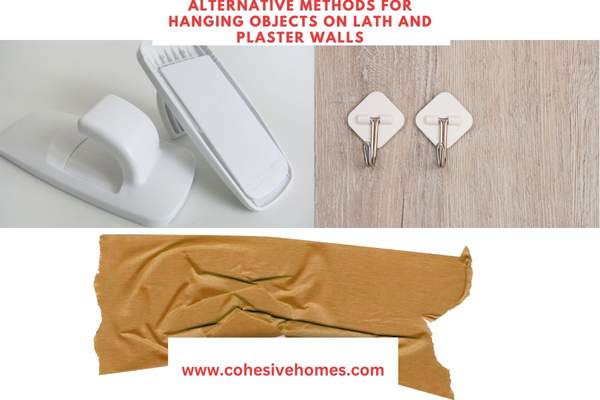
Alternative methods for hanging objects on lath and plaster walls include the use of picture hangers, command strips, magnetic hangers, cup hooks, or adhesive hooks.
People often choose to use picture hangers because they can hold lightweight to medium objects. Picture hangers are specifically designed for this purpose.
Command strips are another option and are designed to be easily removed without damaging the wall.
Magnetic hangers use strong magnets to hold objects in place, making them a great option for lightweight objects.
Cup hooks and adhesive hooks are also popular choices and are easy to install without damaging the wall.
Hang objects on lath and plaster walls securely using alternative methods without heavy-duty hardware or finding studs.
Maintenance and upkeep for hanging objects on lath and plaster walls

It’s crucial to maintain and keep up with hanging items on lath and plaster walls to make sure they stay firmly in place.
Check the items frequently to ensure they are still hung firmly, and tighten any slack screws or nails as necessary.
If you’re using an alternate approach, like command strips, make sure the adhesive is still firm and change the strips as needed.
It is advised to regularly check the hardware on large items to make sure it is still firmly connected to the wall.
Not only will maintaining and caring for your hanging items assist in keeping them firmly in place, but it will also help to protect your walls from any harm.
Conclusion
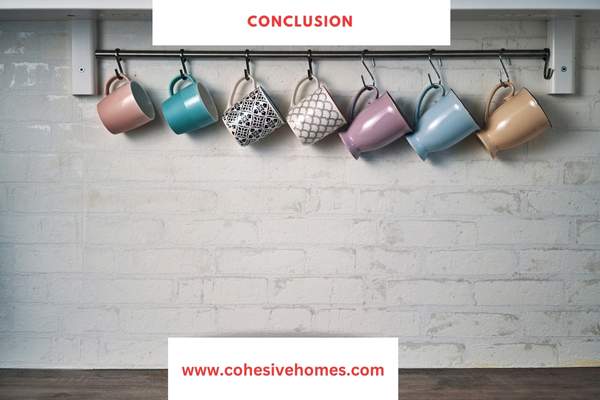
Hanging objects on lath and plaster walls requires a bit of extra care and attention to ensure that the delicate walls are not damaged.
Choosing the right hardware, finding the studs, using alternative methods, and maintaining and keeping up with the hanging objects are all important steps in the process.
By following these tips and guidelines, you can hang objects securely and safely on your lath and plaster walls and enjoy your beautiful wall décor for years to come.
FAQS
How to find studs in lath and plaster walls?
Use a stud finder, tap, or measure.
What is the best hardware for lath and plaster walls?
Toggle bolt, molly bolt, or picture hanger
Is it possible to hang heavy objects without causing damage?
Yes, by using proper hardware and finding studs or using alternative methods.
